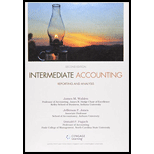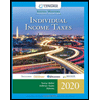
1.
Prepare journal to record the entry for income tax of Company R at the end of 2016.
1.
Explanation of Solution
Operating loss carryback: Carry back of net operating losses can help provide cash infusion for business taxpayers by offsetting net income in previous years, resulting in a tax refund.
Prepare journal to record the entry for income tax of Company R at the end of 2016:
| Date | Accounts title and explanation | Post Ref. |
Debit ($) |
Credit ($) |
| 2016 | ||||
| December 31 | Income tax refund receivable (1) | 33,150 | ||
|
Income tax benefit from operating loss carry back | 33,150 | |||
| (To record the income tax refund from operating loss carryback) | ||||
| December 31 | 4,500 | |||
|
Income Tax Benefit From Operating Loss Carry Forward | 4,500 | |||
| (To record deferred tax asset for carry forwarding operating loss) | ||||
| December 31 | Income Tax Benefit from Operating Loss Carry forward | 4,500 | ||
|
Allowance to reduce deferred tax asset to realizable value | 4,500 | |||
| (To record the creation of valuation allowance for deferred asset) |
Table (1)
December 31, 2016: To record the income tax refund from operating loss carryback:
- Income tax refund receivable is asset and it is increased. Thus, it is debited.
- Income Tax Benefit from Operating Carry Forward is a component of
stockholders’ equity and increases, so credit it for $33,150.
December 31, 2016: To record deferred tax asset for carry forwarding operating loss:
- Deferred Tax Asset is an asset and increases, so debit it for $4,500.
- Income Tax Benefit from Operating Carry Forward is a component of stockholders’ equity and increases, so credit it for $4,500.
December 31, 2016: To record the creation of valuation allowance for deferred asset:
- Income Tax Benefit from Operating Loss Carry forward is a component of stockholders’ equity and decreased, so debit it for $4,500.
- Allowance to reduce deferred tax asset to realizable value is a contra asset and decreased, so credit it for $4,500.
Working note: 1: Calculate the amount of income tax refund receivable:
| Year | Revenues | Expenses | Taxable income | Tax rate | Refund |
| (1) | (2) | (4) | |||
| 2014 | $253,000 | $180,000 | $73,000 | 30% | $21,900 |
| 2015 | $241,000 | $196,000 | $45,000 | 25% | $11,250 |
| Total | $118,000 | $33,150 |
Table (2)
Working note 2: Compute the deferred tax asset:
2.
Prepare the lower portion of Company R’s income statement for 2016.
2.
Explanation of Solution
Income statement: The financial statement which reports revenues and expenses from business operations and the result of those operations as net income or net loss for a particular time period is referred to as income statement.
Prepare the income statement of Company R for 2016:
| Company R | |
| Income Statement | |
| For the year ended December 31, 2016 | |
| Revenues | $60,000 |
| Less: Expenses | ($193,000) |
| Pre-tax operating loss | ($133,000) |
| Less: Income tax benefit from operating loss carryback (3) | ($33,150) |
| Net Loss | ($99,850) |
Table (2)
Note: Company R incurred a pre-tax operating loss of $15,000 that can be carried forward for 20 years to offset the future assessable income and lessen the income tax.
Thus, the net loss of Company R for 2016 is $99,850.
3.
Prepare the
3.
Explanation of Solution
Prepare the journal entry to record the receipt of the refund check on June 1, 2017:
| Date | Accounts title and explanation | Post Ref. | Debit ($) | Credit ($) |
| June 1, 2017 | Cash (1) | 33,150 | ||
| Income Tax Refund Receivable | 33,150 | |||
| (To record the receipt of check on account of tax refund) |
Table (3)
- Cash is an asset and increases so debit it for $33,150.
- Income Tax Refund Receivable is an asset and decreases, so credit it for $33,150.
4.
Prepare journal to record the entry for income tax of Company R at the end of 2017.
4.
Explanation of Solution
Prepare journal to record the entry for income tax of Company R at the end of 2017:
| Date | Accounts title and explanation | Post Ref. | Debit ($) | Credit ($) |
| 2017 | ||||
| December 31 | Income Tax Expense (3) | 3,300 | ||
| Allowance to Reduce | 4,500 | |||
| Income Taxes Payable | 3,300 | |||
| Deferred Tax Asset (2) | 4,500 | |||
| (To record the income tax expense with the deferred tax asset) |
Table (4)
To record the income tax expense with the deferred tax asset:
- Income Tax Expense is a component of stockholders’ equity and decreases, so debit it for $3,300.
- Allowance to reduce deferred tax asset to realizable value is a contra asset and decreased, so credit it for $4,500.
- Income Taxes Payable is a liability and it is increased. Thus, it is credited.
- Deferred Tax Asset is an asset and decreases, so credit it for $4,500.
Working note 3: Compute the income tax payable for the year 2017:
| Computation of income tax payable | |
| Revenues | $181,000 |
| Less: Expenses | ($155,000) |
| Pre-tax operating income (a) | $26,000 |
| Less: Operating loss carry forward | ($15,000) |
| Net Loss | $11,000 |
| Less: Income tax rate (b) | 30% |
| Income taxes payable | $3,300 |
Table (5)
5.
Prepare the income statement of Company R for 2017.
5.
Explanation of Solution
Prepare the income statement of Company R for 2017:
| Company R | |
| Income Statement | |
| For the year ended December 31, 2017 | |
| Revenues | $181,000 |
| Less: Expenses | ($155,000) |
| Pre-tax income | $26,000 |
| Less: Income tax expense | ($3,300) |
| Net income | $22,700 |
Table (6)
Thus, the net income of Company R for 2017 is $22,700.
Want to see more full solutions like this?
Chapter 18 Solutions
Intermediate Accounting: Reporting and Analysis (Looseleaf)
 Intermediate Accounting: Reporting And AnalysisAccountingISBN:9781337788281Author:James M. Wahlen, Jefferson P. Jones, Donald PagachPublisher:Cengage Learning
Intermediate Accounting: Reporting And AnalysisAccountingISBN:9781337788281Author:James M. Wahlen, Jefferson P. Jones, Donald PagachPublisher:Cengage Learning
 Individual Income TaxesAccountingISBN:9780357109731Author:HoffmanPublisher:CENGAGE LEARNING - CONSIGNMENT
Individual Income TaxesAccountingISBN:9780357109731Author:HoffmanPublisher:CENGAGE LEARNING - CONSIGNMENT



